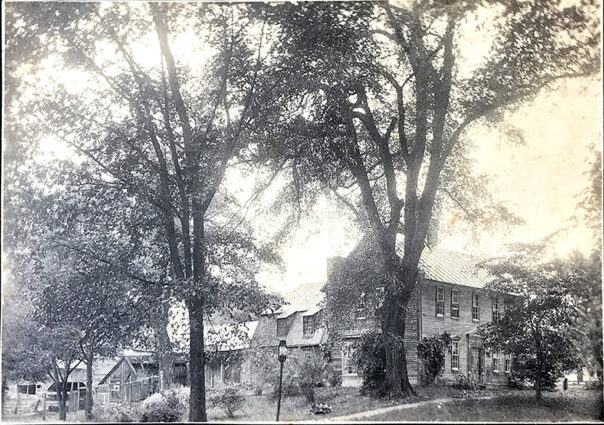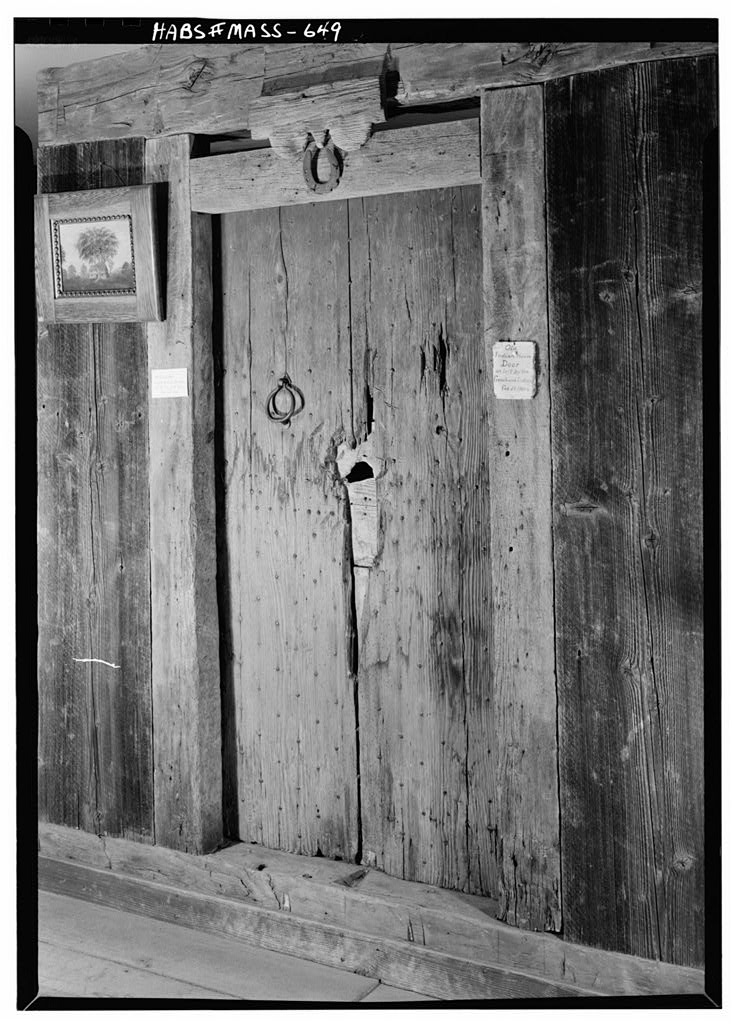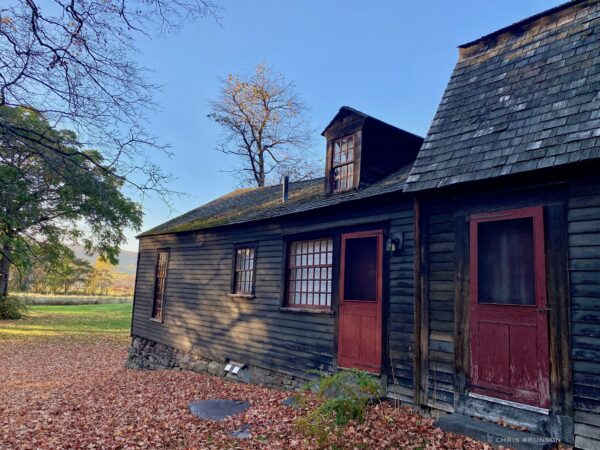Then & Now: Deerfield. Brattleboro. Books. Simon Donato, Bethany
“How many things are looked upon as quite impossible until they have been actually effected.”–Pliny
A tidal flow of vehicles and visitors. North from Connecticut and elsewhere.

Then. The Sheldon House (1754) “…was home to town historian George Sheldon (1818-1916), who was instrumental in forming the Pocumtuck Valley Memorial Association and authored the two volume work, A History of Deerfield. Image Historic Deerfield, linked to amazing then and now images (One image fades into another with viewer's choice of when.).
Travel is like a big wooden spoon, stirring up memories and connections that add to the stew of life. All heard and walked. Read, discussed.
When the tide recedes, fertilizer in the form of money left behind, goods exchanged. Time spent, weary from hike, walk, explorations, food and picnic; satiated seeing and learning. Humanity has been moving around by season for quite some time. On foot, by water. With livestock, horseback. Then wheels powered by engines and fuel. Now there are vehicles plugged in, powering up.
Thank you. Thank you. Thank you. Alive, recovering. A journey through grief, a new chapter opens. Writer, write.
(And remember what it is like not to know.) Ask questions. Such as: Where does the wastewater go from the very busy Vermont Welcome Center?
Answer. To nearby Brattleboro via sewers.
More than 800,000 humans a year flow through the Guilford Vermont Welcome Center. Water. Flushing, hand washing. No solar panels on roofs though; that's a question for another day.
Weekend one, Middlebury, Vermont. Next, Brattleboro, then backroads and detours. The story of a door called us to Historic Deerfield, Massachusetts. After hours, so missed opportunity to tour the museum collections. But timed just about perfectly to walk and see the late-day October light illuminate the landscape, light up sugar maples, the clear yellow of nut trees.
Curiosity. Conversations during recent explorations ran the gamut of butternut trees decline (why). Carbon capture, methods. How this works. How do you tell who is spouting buzzwords to those truly dedicated to mitigating climate disaster.
In a darkened car, reading William Shatner's words about his view of our beloved and beautiful planet.
Architecture viewed, what is the purpose of this building? Original use, purpose.
“I had a different experience, because I discovered that the beauty isn’t out there, it’s down here, with all of us. Leaving that behind made my connection to our tiny planet even more profound.”
William Shatner https://t.co/UukTAFpvZn pic.twitter.com/cLhThqFPCQ
— Moo Dog Press (@MooDogPress) October 17, 2022
Trails. People. Boots. Books. Walkable streets. Signs to welcome all types of humans. Water bowls placed for dogs. Crosswalks that chirp and talk (a bit startling at first). Decorations. Art exhibits. Noting license plates from Nevada, Massachusetts, Connecticut. Dogs. Businesses from clothing and outdoors apparel to consignment. Supporting services. Groceries, repairs, watercraft rentals. Magazines, publications, news (yes, print). Locations of businesses in plazas, away from town centers.
Connectivity. Waze. GPS. Maps. Content related to what is seen, heard. read. What is nearby?
Plus the glorious October light. Sugar maples showing off. No frost. Yet. Wild turkeys. Deer. Check when hunting allowed, each state. Orange vest and hat, check. Views and winding drives on one-lane road to summit. Chairs of stone with inscriptions, memorials. Remember me.
“The Pocumtuck people, whose homelands included the land that would eventually be named Deerfield by the English settlers, were connected culturally and through language to the Algonquian people. In addition to Pocumtuck, the Norowottuck, Sohoki, Abenaki, Mahican, Wampanoag, Narragansett, Nipmuc, Pennecook, Pigwacket, Pequot, and Mohegan were a part of the Algonquian ‘network.'” —Native American Presence in Deerfield, Massachusetts (Also see http://www.native-languages.org/pocomtuc_culture.htm
The more seen, additional wondering results. What does “-paug” as a wood root mean? Where are the collections of Native American tools for fishing, hunting, living? Stories, paths, villages, pottery. (How to store or carry water? Before glass, metal, plastic.) Revered spots for those who passed on. Hidden history, but it is everywhere. Let's go, find.
And the bulldogs all have rubber teeth
And the hens lay soft-boiled eggs
Back to that door. A battered, chopped door for Deerfield is now in a museum, the original house taken down.

Speak, door. John Sheldon House, Memorial Hall Museum, Deerfield, Franklin County, MA
Contributor Names
Historic American Buildings Survey, creator
Created / Published
Documentation compiled after 1933
Subject Headings
– houses
– fragments
– Massachusetts — Franklin County — Deerfield
Notes
– Fragments of original house, demolished in 1848
– Significance: The “Old Indian House” was built in Deerfield about 1698 for Capt. John Sheldon. It survived the massacre of 1704, when about half of the village was burned, and remained intact except for deterioration until 1848, when it was demolished. Several fragments are now preserved in Memorial Hall in Deerfield.
– Unprocessed Field note material exists for this structure: FN-183
– Survey number: HABS MA-649
– Building/structure dates: 1698 Initial Construction
– Building/structure dates: 1848 Demolished
Historic Deerfield: Then and Now
For more than 300 years, the village of Old Deerfield has seen its share of changes, while many things have remained the same. This online interactive photographic exhibition shows photographs of Historic Deerfield buildings and landscapes from its past and present. To see the changes, simply click on each picture to see how it is in the present day. (Link follows.) The rich dark earth bordering the Deerfield River. Tree-lined street and it is beautiful. Homes, then and now.
Yes, a butternut that looks happy and healthy, mature. Then seeing more. May squirrels, chipmunks. Crows above. The scent of New England is not in a candle. It's a blend of crushed leaves, stone walls, vegetation, water; aromas mingled and distinct. Time to rest, drop leaves, become more still. Read, read, read.
Rows of cut, split wood stacked neatly on porches. Steep roofs with metal at edges. Snow eagles.
Thoughts of the week between and a new book in progress, Bethany and Woodbridge. A sturdy fence seen, new barn. Oreo cows?
That sign “Organic Wood” from another conversation and interview with Simon Donato that ranged from farmers market at Long Wharf in New Haven to Hartford's Market. A vegetable stand when he was 10. There's that entrepreneurial mindset again. His next book is with his editor now.
Local history, deep time. Simon. pic.twitter.com/TfuAvWIZOJ
— Moo Dog Press (@MooDogPress) October 21, 2022
Inspiring.
Getting the word out, to vote. https://t.co/hTMeVqWKkV
— Moo Dog Press (@MooDogPress) October 21, 2022
Despite all of our challenges, this is still the best time in history to be alive.
— Esther Crawford ✨ (@esthercrawford) October 18, 2022
“You gain strength, courage and confidence by every experience in which you really stop to look fear in the face. You are able to say to yourself, ‘I have lived through this horror. I can take the next thing that comes along.' You must do the thing you think you cannot do.” ― Eleanor Roosevelt, You Learn by Living
Show and tell, interlude. Look. Seek. Find. Learn layers of human inhabitation. Curious about what tool was used to hack the door? Literally, people on one side trying to get those on the other. Context. From that story, note the mention of “an enslaved woman”–
“The Williams home was one of the first attacked. It was ransacked and the family seized; two of the children and an enslaved woman were killed at once. Mrs. Williams, only recently delivered of her eighth child, died on the second day of the march.”
Before Europeans, this.
“Also around 12,000 years ago, a group of Paleoindians established a site, now called the Turners Falls site, in Montague, Massachusetts, which is located in the Connecticut River Valley in the western part of the state. The site is located on a sandy ridge near the Turners Fall municipal airport. In addition, other sites around the airport show evidence of Native American occupation during the Middle and Late Archaic Period and during the Woodland Period. Artifacts found at the Turners Falls site include fluted points, scrapers, gravers and edge tools made out of jasper.”
Source: History of Massachusetts. Reading deeper to then continue a journey to learn.
Editor's note: This story has been updated.

